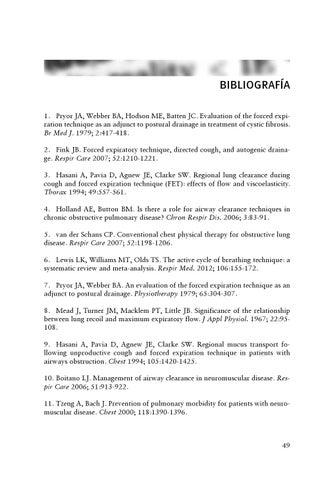BIBLIOGRAFĂA 1. Pryor JA, Webber BA, Hodson ME, Batten JC. Evaluation of the forced expiration technique as an adjunct to postural drainage in treatment of cystic fibrosis. Br Med J. 1979; 2:417-418. 2. Fink JB. Forced expiratory technique, directed cough, and autogenic drainage. Respir Care 2007; 52:1210-1221. 3. Hasani A, Pavia D, Agnew JE, Clarke SW. Regional lung clearance during cough and forced expiration technique (FET): effects of flow and viscoelasticity. Thorax 1994; 49:557-561. 4. Holland AE, Button BM. Is there a role for airway clearance techniques in chronic obstructive pulmonary disease? Chron Respir Dis. 2006; 3:83-91. 5. van der Schans CP. Conventional chest physical therapy for obstructive lung disease. Respir Care 2007; 52:1198-1206. 6. Lewis LK, Williams MT, Olds TS. The active cycle of breathing technique: a systematic review and meta-analysis. Respir Med. 2012; 106:155-172. 7. Pryor JA, Webber BA. An evaluation of the forced expiration technique as an adjunct to postural drainage. Physiotherapy 1979; 65:304-307. 8. Mead J, Turner JM, Macklem PT, Little JB. Significance of the relationship between lung recoil and maximum expiratory flow. J Appl Physiol. 1967; 22:95108. 9. Hasani A, Pavia D, Agnew JE, Clarke SW. Regional mucus transport following unproductive cough and forced expiration technique in patients with airways obstruction. Chest 1994; 105:1420-1425. 10. Boitano LJ. Management of airway clearance in neuromuscular disease. Respir Care 2006; 51:913-922. 11. Tzeng A, Bach J. Prevention of pulmonary morbidity for patients with neuromuscular disease. Chest 2000; 118:1390-1396.
49
